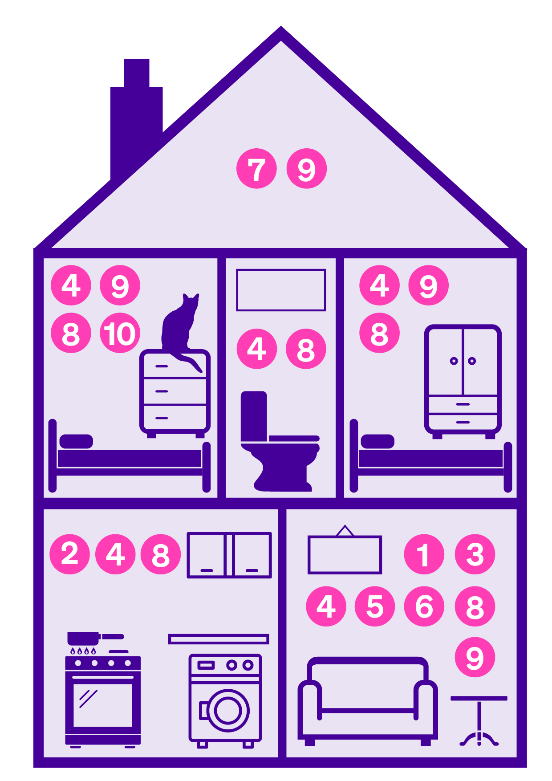What is indoor air pollution?
We might think of pollution as something that’s outside, like fumes from vehicles and factories. But there are things that pollute the air inside too. For example, cigarette smoke, cleaning products.
Indoor air pollution also includes allergies to things in your home. The most common indoor allergens are dust mites, mould and pets.
Indoor air pollution can be anywhere, including home, work, or school.
What causes indoor air pollution?
This picture shows the different rooms that you might have in your home. We’ve labelled the most common sources of indoor air pollution and where you may find them in your home. The list shows what the numbers in each room mean.
You can find out more about each type of indoor air pollution by clicking on the links in the list.

- Heating
- Cooking
- Smoke and vapour
- Sprays and aerosols
- Furniture
- Painting and decorating
- Building materials
- Damp and mould
- Dust mites
- Animals and insects
How does indoor air pollution affect your health?
At the moment, scientific evidence shows that small amounts of indoor air pollution can cause:
- dizziness
- headaches
- extreme tiredness (fatigue)
- eye, nose and throat irritation.
If you’re exposed to indoor air pollution over a longer period of time, it can cause lung conditions like asthma, COPD and lung cancer. It can also increase your risk of having a stroke and cause heart disease.
However, more research is needed to fully understand the health effects of indoor air pollution.
Who is most affected by indoor air pollution?
Anyone can be affected by indoor air pollution, but you’re more at risk if you’re:
- a baby or child
- older
- pregnant
- living with a lung condition
- from a low income household
- living in poverty.
Heating
Help with heating costs
We know that the rising cost of living is affecting people across the UK. Find out if you can get help with heating costs.
Wood burning stoves and open fires
Burning wood or coal on a stove or in an open fire releases tiny particles called particulate matter (PM). PM is the most dangerous type of pollution for our health.
PM can cause wheezing and coughing and can make lung conditions like asthma and COPD worse. It has also been linked to heart conditions, strokes, mental health issues and dementia. We have more information about how PM can harm your lungs.
In the UK, wood burning stoves and open fires almost release as much PM as cars and road traffic.
If possible, avoid using wood burners, especially if you have a lung condition.
The government has more information about how wood burning stoves and open fires can impact your health, including advice about improving how you burn fuel at home.
The government also has a guide to picking environmentally-friendly heating products in your home.
Central heating
Most people in the UK use gas central heating to warm their homes. Gas central heating can also affect your indoor air quality, as it releases pollutants like carbon dioxide and nitrogen oxides.
If you have gas central heating in your home and are unable to change it, get your appliance checked by a Gas Safe registered engineer every year. If you’re renting, this is your landlord’s responsibility.
Electric heating is a safer and more environmentally friendly option. Energy Saving Trust has more information about electric heating, including how it can save you money.
The government’s guide to picking environmentally-friendly heating products in your home includes information about grants available to help you switch heating systems.
Carbon monoxide
Carbon monoxide is a poisonous gas. It has no smell or taste. It’s created when fuels like gas, oil, coal, or wood do not burn fully.
If you’re exposed to carbon monoxide you might get headaches, fell tired, find it difficult to think clearly or feel sick. If you continue to be exposed to it, it can kill you within a few hours.
Putting a carbon monoxide alarm in the same room as your boiler, cooker or wood-burning stove could save your life. If you rent, your landlord must fit your home with a carbon monoxide alarm.
The government has more information about what to do if you think you are exposed to carbon monoxide.
Damp and mould
It’s important to deal with damp and mould as quickly as possible, especially if you have a lung condition. Damp and mould can be very harmful to your health.
Damp happens when there is a buildup of moisture in a building. Damp can cause mould to grow. Mould is a type of fungus that grows in moist places.
Mould usually grows in moist areas like windows, leaks and pipes. It can also grow on carpets and soft furnishings. If you have mould, you might notice spots in different colours, like black, white, yellow or green.
Mould smells musty. You might be able to smell mould in your home, but not see it. Mould can grow behind surfaces, like on the back of wallpaper, tiles and carpet.
Damp and mould is very bad for your lungs. It can cause:
- rhinitis (when your nose is irritated)
- infections, like aspergillus and flu
- coughing, wheezing and breathlessness
- lung conditions, like asthma, chronic obstructive pulmonary disorder (COPD) and hypersensitivity pneumonitis.
If you have a lung condition, damp and mould can make your symptoms worse. You’re also more likely to get infections from breathing in damp and mould.
Managing damp and mould
- Get rid of mould as soon as possible. The Centre for Sustainable Energy has more advice about treating mould.
- Condensation is one of the main causes of damp and mould. Find out how to prevent condensation and improve your indoor air quality.
- If you rent your home, get more advice and support from Citizens Advice and Shelter.
Dust mites
1 in 2 people with a lung condition told us that dust made their condition worse in our 2024 Life With a Lung Condition survey.
This is because of dust mites. Dust mites are small insect-like pests that you can’t see. We all have dust mites in our homes.
Being allergic to dust mites is very common and normally affects people with lung conditions like asthma or allergic rhinitis. If you're allergic to dust mites, you might get allergy symptoms, such as:
- sneezing
- a runny nose
- watery eyes.
Speak to your GP or nurse if you think you’re affected by dust mites. They may be able to offer you tests to see if you’re allergic. It’s important to see your GP or nurse as your symptoms could be caused by other things, like pollen or mould.
If you’re allergic to dust mites, your GP or nurse will speak to you about things that could help. This might include:
- avoiding and reducing dust where possible
- managing your lung condition well
- medicines like antihistamines and steroid nasal sprays.
Getting rid of dust mites
It’s impossible to get rid of dust mites completely, but you can try to reduce the amount of dust mites where you live.
Dust mites like warm, humid, and damp places. They like to live in bedding, carpets and soft furnishings, like blankets and pillows. Try to focus on reducing dust mites where you sleep and in your living areas first because this is where there are the most dust mites.
There are some free and low-cost things you can try:
- Get rid of any soft furnishings that you do not need, for example cushions, rugs and throws. This reduces the amount of places dust mites can live.
- Clean your surfaces with a damp cloth at least once a week. Using a damp cloth will help stop dust from getting in your mouth and nose.
- Lower the humidity where you live by keeping it well-aired. If you can, open your windows regularly, use an extractor fan in your bathroom and kitchen, and avoid drying your washing inside.
- Wash your bedding and soft furnishings regularly. A 60°C wash will kill dust mites.
- Vacuum weekly. Vacuum cleaners with HEPA (High Efficiency Particulate Air) filters can trap more house dust mites than other vacuum cleaners.
If you’re able to, you could also:
- Avoid using second-hand mattresses.
- Use allergen-proof barriers on mattresses and pillows.
- Get rid of your carpets or rugs. You could replace them with wood, vinyl, or laminate flooring, which is easier to clean. If you rent, see if your landlord would consider replacing carpet with a different type of flooring.
Cooking
Gas cookers release particulate matter (PM) and other pollutants into the air.
Gas cookers can harm your lungs and cause symptoms like coughing, wheezing and can make your lungs not work as well.
Gas cookers can also give off fumes that can trigger asthma attacks, especially in children.
Current research suggests that electricity is the cleanest energy to use for heating and cooking. If possible, you may want to consider switching to an electric cooker, especially if you have a flare-up of your symptoms from using a gas cooker.
How to improve your air quality while using a gas hob or oven
Use an extractor fan or open windows:
- Keep the room well aired by using an extractor fan when you are cooking
- If you don’t have an extractor fan, open windows every time you cook
- Clean grease off your extractor fan regularly so it works as well as possible
- Leave the extractor fan on or keep your windows open for 10 minutes after cooking.
Other ways to stay safe:
- Use electric appliances as much as possible. For example boil water in an electric kettle before putting it into a pot
- Use plug-in air fryers, microwaves, slow cookers and toasters if you can, instead of cooking on a gas hob
- Keep the hob flame underneath your pot or pan.
Smoke and vapour
Cigarette smoke
Second hand smoke has over 4,000 harmful toxins and chemicals in it. Smoke can stay in the air for two to three hours after someone’s finished a cigarette, even if you open a window.
The best way to keep these dangerous chemicals out of your home is to quit smoking if you, or anyone you live with, smokes. If you’re not ready to quit, always smoke outside.
Second hand smoke is especially dangerous for children, as their lungs are still developing.
We have more information about support to help you quit.
Vapour from e-cigarettes
The vapour from e-cigarettes is thought to be less harmful than tobacco smoke, but we know that some people with lung conditions are sensitive to second hand vaping. In our 2024 Life with a Lung Condition survey, almost 1 in 3 people told us that other people vaping triggered their lung condition.
Scented candles and incense
Candles and incense release particulate matter (PM) and other pollutants when they burn.
In some cases, scientists have found that incense releases more PM than cigarettes.
It’s a good idea to light candles in well-aired, large spaces instead of smaller spaces like bathrooms. Try opening windows while burning candles, if possible. You could also use battery-operated candles.
Smoke from your neighbours
We know that people with lung conditions are often worried about smoke from their neighbours or communal spaces coming into their homes. Action on Smoking and Health has more information about managing smoke drift.
Sprays and aerosols
Many everyday cleaning and cosmetic products release pollutants like volatile organic compounds (VOCs) and particulate matter (PM).
These pollutants can cause allergic reactions or headaches. They can also make your lung condition symptoms worse. In our 2024 Life with a Lung Condition survey, 4 in 10 people told us that aerosols and perfumes triggered their lung condition.
This includes household cleaning products, for example disinfectant sprays, air freshener and laundry products. It could also be cosmetic products such as soaps, perfumes and deodorants.
Furniture
Some furniture contains a volatile organic compound called formaldehyde. Formaldehyde is commonly used in the production of wooden products and furniture, including shelving, furniture, cabinets and flooring underlay.
If you have a lung condition like asthma, you might be more sensitive to formaldehyde.
Being exposed to a small amount of formaldehyde should not affect your health, but there are things you can do to protect yourself:
- Keep your home well-aired.
- Do not smoke or vape inside. Smoking and vaping can also produce formaldehyde.
- If you’re buying new furniture, try to pick products that contain small amounts or no formaldehyde. In the UK, furniture companies with a FIRA Gold certification have a limited amount of formaldehyde in their products.
Painting and decorating
Painting and decorating materials such as varnishes, glues, paints and paint strippers can contain volatile organic compounds (VOCs).
Scientists are still researching the full health effects of VOCs, but right now we know that VOCs can cause:
- eyes, nose and throat irritation
- breathing problems
- headaches
- dizziness.
Some painting and decorating products have a globe symbol on the packaging that tells you the amount of VOCs in the product. You can find out more about this labelling scheme on the British Coatings Federation website.
Building materials
Asbestos
Asbestos is a risk to lung health. It has been banned in the UK since 1999, but older buildings may still have asbestos in them.
Before we knew about the dangers of asbestos, it was often used in buildings for insulation, flooring and roofing, and sprayed on ceilings and walls. Breathing in asbestos fibres can lead to lung conditions such as asbestosis and mesothelioma.
If you think there is asbestos in your home, do not touch or disturb it. We have more detailed information on what to do if you think you’ve been exposed to asbestos.
Radon
Radon is a natural radioactive gas that comes from rocks and soil. You cannot see it or smell it. Some homes in the UK are built in areas with high radon levels.
Being exposed to high levels of radon for long periods of time can cause lung cancer.
The government has more information about radon, including how to check if there’s radon in your home and how to reduce radon levels in your home.
Animals and insects
Pet allergies
The protein in an animal’s saliva, pee or dander (shed skin particles) can cause an allergic reaction. You can be allergic to any animal, but cat and dog allergies are more common as they release more proteins.
Pet allergies are especially common if you have asthma. In our 2024 Life With A Lung Condition Survey, 1 in 5 people told us that pets triggered their asthma symptoms. We have more advice about managing a pet allergy if you have asthma.
Pests
Pests in your home, such as cockroaches, rats, mice or can cause allergic reactions and trigger asthma symptoms.
If you rent, your landlord will probably be responsible for getting rid of pests. Find out more on Citizen’s Advice’s website.
If you own your home, you can use the government website to find out about pest control services that your local council offer.
The British Pest Control Association have detailed information about all of the different pests in the UK, including information about how to prevent, notice and treat infestations.
Professional pest control
It’s best to get professional pest control services to get rid of pests, so you get someone professionally trained to deal with infestations
It can be dangerous to use pest control products by yourself at home. Usually, products you can buy yourself will not be as safe or effective as the products that professionals have access to.

Get support
Call or email our helpline for support with your condition. Get advice on medicines, symptoms or travelling with a lung condition. You can also find support through our groups.








